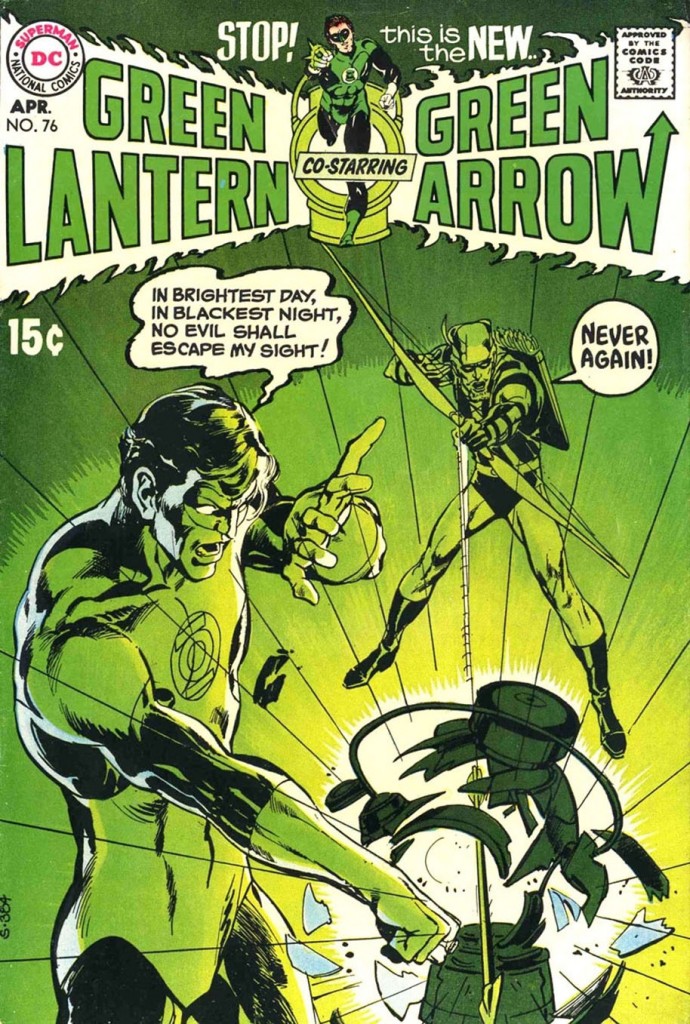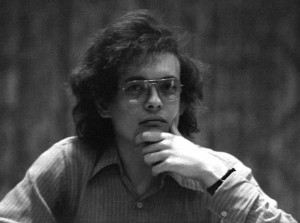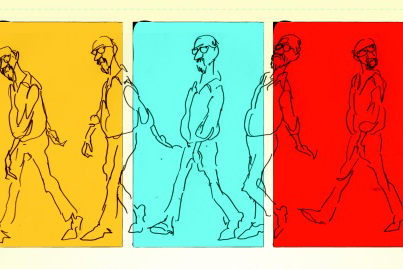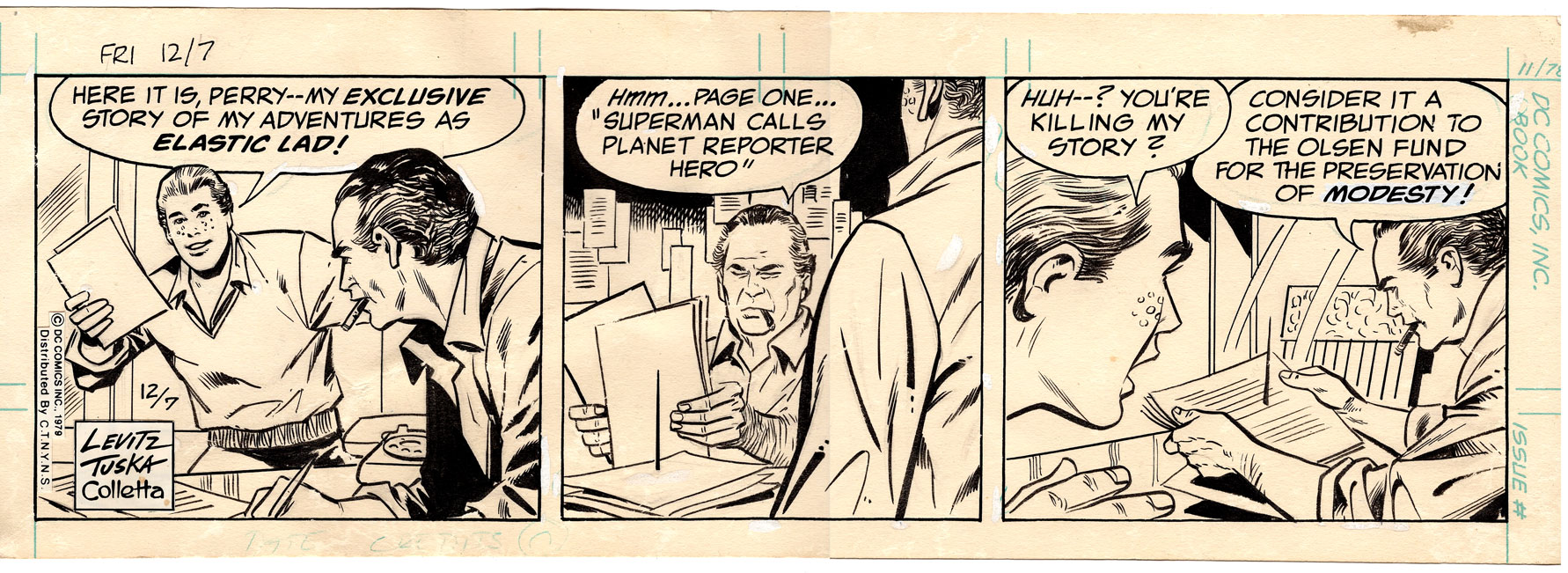My words never looked better than when rendered in the careful calligraphy of Gaspar Saladino, and if I must say farewell to him, I won’t do it referring to him by his most frequent but inadequate title of ‘letterer.” Gaspar was an artist with design, creating logotypes that have endured and influence, ads that sent us running to the newsstand, and what he did with “simple” sound effects or words in balloons. His work on Len Wein & Bernie Wrightson’s SWAMP THING run established a new level for what lettering could do to add to storytelling in periodical American comics, bringing more drama with his innovative style.
I grew up enjoying Gaspar’s uncredited work, mostly on Julie Schwartz’s titles, and then was delighted to meet the man and have the opportunity to have him render my awkward sketches into a beautiful logo for ADVENTURE COMICS and to have him collaborate by bringing his talent to my comics and newspaper strip run. He was a smiling craftsman, enjoying each challenge or even routine task. I’m sad to hear that he’s passed, but I have beautiful examples of his talent hanging on my walls to cherish with my memories.
Noel Neill passed, and the world lost a small beacon of courage, charm and character. Like most of my generation, I ‘met’ her through her portrayal of Lois Lane on THE ADVENTURES OF SUPERMAN, conjuring a 1950s combination of Nellie Bly and MY GAL FRIDAY. But I was lucky enough to actually befriend her in my years at DC. Her sparkle didn’t diminish with age, and she was a Lois that made it easy to imagine why Superman might have picked her out of all the women in the world.
One brief tale: about a decade ago, Noel called to ask my advice. She’d been invited to the premiere of HOLLYWOODLAND, the film about the death of George Reeves. She was concerned that going might hurt her relationship with DC (as if anything could damage our fondness for her). I reassured her, but she was still nervous and wavering, trying to decide. After unsuccessfully encouraging her to just go and have fun, I tried the tact of asking if George would have wanted her to go. That decided her–the sensitivity of her long dead friend’s feelings were much more important than whether she’d have a good time.
Thanks for the performances, Noel, your friendship, and the occasional pleasure of hearing your unchanging and ever delightful voice.
One of the highest peaks creative work can achieve is personal vision—that nirvana when a writer or artist is able to produce something that is unique, peculiarly and utterly their own. And on that peak, a summit is reached when that personal vision is shared and delights an audience.
Darwyn Cooke climbed the mountain in comics with personal vision, and with a distinctly different track than almost any other creator. After achieving success as an animator, he simply woke up one day and decided to try his hand at comics, and from the first comics he produced, did them as brilliantly as any of his generation. His NEW FRONTIER reimagined the entire DC universe in the context of the times in which it was originally published, a time just before Darwyn’s own, and in a country and culture just adjacent to the one he grew up in. It was true masterwork, outrageous as a first effort in the form.
Accomplished and acclaimed as he was, Darwyn was appreciative of those whose groundwork formed the foundation for the mountain he climbed. Invited to share a panel dais with Jules Feiffer to talk about noir, his blush was almost visible in the bytes of his response. The truth was, his work on the PARKER graphic novels would bring a younger (and larger) crowd to the discussion than the audience for Feiffer’s KILL MY MOTHER, but Darwyn’s respect and admiration for Feiffer came out in his sense of honor at being invited to speak as the older man’s peer.
I have a particular hatred of lung cancer for its toll in my family, and now add to that my anger at it taking from us an extraordinary talent, performing at his peak, and with so much more to give the world. Farewell, Darwyn, and know that we are richer for you having shared your vision of heroes with us.
Not my favorite part of teaching, this is the week where final projects come in to be graded. Tell the truth, I didn’t much care for grading on any basis: as a student, I was never particularly grade-hungry (and was lucky enough to be part of a generational cohort where having insanely perfect grades wasn’t a requirement to get into a good school, especially coming from Stuyvesant, whose grades were considered on a steep curve by most of the colleges at the time); as a manager, I much preferred ‘essay’ type reviews for my team to the “check the boxes” type; and the only thing I like less as a teacher than grading projects/papers is giving tests, which are silly when dealing with students taking writing courses or doing graduate-level work.
For the courses I’ve taught repetitively, I’ve developed final projects that I think add to the learning process. For my writing course at Manhattanville, I ask the students to develop a pitch–it can be for a novel, a screenplay, a comic, or a business-to-business proposition. Pitching yourself and your ideas is a fundamental task in life, and writing is one of the best ways to learn it. Develop a good written pitch and you think about the structural elements you’d use in a verbal presentation, too. I’ve had some charming and skilled ones over the last few years, and some less so, of course. But I got the surprise this year of a graphic novel pitch that is of publishable quality, which I hope to help the student find a path to publishing. For transmedia: the future of publishing, one of my grad courses at Pace, I ask the students to envision how technology and cultural change will shift a category of publishing in the next few years. I think of it as the Fred Smith challenge. He envisioned the possibility of FedEx in his grad school thesis, and then both improved the world and got rich in putting into effect. Kind of a high goal, but they can get an “A” without hitting that bar.
Time to see what’s in the pile waiting…
If you came to love DC comics first in some faraway place, say a thankful farewell to Phyllis Hume today. Phyllis had one of those jobs invisible to the general public, unacknowledged on any masthead, but vital to changing the world’s comics culture. She began her involvement with DC as a paralegal in the corporate trademark department, but really made her impact in long decades managing DC’s international rights. She travelled relentlessly for decades, building partnerships and true friendships across the globe, and working to get comics published by people who loved comics.
A tough little woman from Brooklyn Heights, Phyllis helped make possible some of the first truly beautiful editions of American comics, long before DC (or any American comics publisher) was ready to produce oversize hardcovers, or art book-quality volumes. Titles from WATCHMEN to ancient classics like CAPTAIN MARVEL AND THE MONSTER SOCIETY OF EVIL happened on her watch, and with her support.
Sadly, she had a rough parting from DC when the international markets changed and she and her then-supervisor saw different paths ahead for the company. One of my regrets as an executive was the occasions like this when I couldn’t bridge gaps between good people and manage to keep both on the team. But those circumstances didn’t detract from my great respect for Phyllis, or appreciation for the work she’d done.
The world of comics is better for the efforts of many largely anonymous people behind the scenes, connecting the creative talents with their audience. We’ve been lucky to have folks doing this who don’t treat it as a job, but as a responsibility to both the talent and the audience. Phyllis Hume was one who made the world of comics larger by making distances, cultures and languages smaller gaps, and for that I’m grateful.
Fun this weekend chatting with Sonny Liew at MoCCA and Midtown Comics for our signing. Email’s a wonderful tool, but nothing really replaces conversation for getting to know each other. The panel celebrating Sonny drew a full house, and we want through a slid show of his career (so far), while chatting about details that included some I didn’t know (like Shelly Bond giving him a shot at inking his own pencils on MY FAITH IN FRANKIE, then pulling in Marc Hempel when she saw Sonny wasn’t quite ready), and some Sonny didn’t (the challenges the Minx line faced when chain bookstores gave up on it completely after just a couple of volumes, just as he was doing THE REGIFTERS).
His THE ART OF CHARLIE CHAN HOCK CHYE is getting wonderful reviews, and that was probably a major reason for the enthusiastic audience. We talked about the fact that it may be a unique approach to a graphic novel, mixing history with a completely fictional ‘spine,’ and his process, including a year of research before the year and a half of drawing. He composed it in thumbnail drawings, rather than a formal script.
We also talked about our process on DOCTOR FATE, where we work from a full script that I provide, but often revise bits to take advantage of Sonny’s perspective. We discussed a couple of examples, most notably how his reaction to the character Akila as originally proposed led her to be depicted as much more traditional Egyptian young woman than originally planned.
And a special nod of the head to David Mazzuchelli, who was Sonny’s teacher at RISD, for joining us in the front row…but even more for his efforts encouraging Sonny and connecting him to the American comics world.
Since my executive days ended I’ve been spending about half my time teaching: classes in writing, publishing, transmedia, and the graphic novel, all areas where my practical experience weighs heavily enough to balance for my lack of traditional academic credentials. I had the pleasure of learning from many wonderful teachers, both in classroom settings and in professional ones, and it was always on my bucket list to see if I would enjoy the experience. I do–because (as Karen Berger commented on hearing I was going to teach) “(I) enjoy the sound of my own voice,” but also because the energy of the students can be infectious, and I find myself learning about my subjects as I teach.
Some of the learning is from the preparation for the classes. I just finished “AN EMPIRE OF THEIR OWN,” a great examination of the Jewish entrepreneurs who built Hollywood, which seemed a logical book to read before tightening my syllabus for this fall’s “Comics, Graphic Novels and the Jews” course at Princeton. I was broadly familiar with the history, and had heard a couple of Jack Warner stories from one of the execs at Warner Bros. who had worked with him and was still around when I began showing up there, but there was so much more information and texture in the volume.
Maybe more valuable to me is the learning from codifying theories in order to teach what I’ve done by instinct. Simple lines like character is is revealed by choices, especially by choices with costs, seem to help convey fundamentals of writing. And once codified, serve to remind me of important goals to strive of in my own work.
Off to read Paul Buhle’s “JEWS AND AMERICAN COMICS” next…
Celebrating Denny
 When Denny entered the comics field, intending to stay for a year or two en route to other writing forms, the idea of being celebrated as a comics writer by the public on any level was absurd. Stan had barely begun his promotion of Marvel as a brand (the fabled Merry Marvel Marching Society was only a year old), and the explosion of comics into the larger pop culture that would happen with the BATMAN television series was months away. As his son Larry O’Neil pointed out, his father would never have dreamed at that time of the recognition and success he achieved in the field, something that was still true as I sat across the card table from Denny Friday nights in the mid-1970s. By then we knew comics could be art, and could make a difference in raising consciousness of social issues, but I think all of us who gathered around that poker table have been surprised and gratified to see the world come to agree with us.
When Denny entered the comics field, intending to stay for a year or two en route to other writing forms, the idea of being celebrated as a comics writer by the public on any level was absurd. Stan had barely begun his promotion of Marvel as a brand (the fabled Merry Marvel Marching Society was only a year old), and the explosion of comics into the larger pop culture that would happen with the BATMAN television series was months away. As his son Larry O’Neil pointed out, his father would never have dreamed at that time of the recognition and success he achieved in the field, something that was still true as I sat across the card table from Denny Friday nights in the mid-1970s. By then we knew comics could be art, and could make a difference in raising consciousness of social issues, but I think all of us who gathered around that poker table have been surprised and gratified to see the world come to agree with us.
On a lovely Saturday evening at the Garner Arts Center, a funky old factory converted into a gallery and events space in Rockland County, a bit north of the old WIZARD offices. Garner was giving Denny O’Neil (a Rockland resident for some years now) a lifetime achievement award, and Nyack proclaimed it ‘Denny O’Neil Day.’
Attendees included Dan DiDio (DC generously sponsored the event), Michael Uslan, Larry Hama, Jack C. Harris and Danny Fingeroth, with former O’Neil sidekick Jordan Gorfinkel quietly in the audience. Lots of nice chatting with old friends at the reception, good words from all about Denny’s massive contribution to comics, and delightful to watch as Denny’s son Larry showed up to his father’s surprise to present the award.
 But I think I had the big treat, getting to moderate and grill Denny on the makeshift stage, we talked about whether his the work was art or craft, and he gave a thoughtful answer about his need to approach his writing from its professional goals, without waiting for inspiration. Not a head-on denial of whether it was art, but a clear emphasis on striving for craft.
But I think I had the big treat, getting to moderate and grill Denny on the makeshift stage, we talked about whether his the work was art or craft, and he gave a thoughtful answer about his need to approach his writing from its professional goals, without waiting for inspiration. Not a head-on denial of whether it was art, but a clear emphasis on striving for craft.
Denny credited Stan Lee and Julie Schwartz as the most important influences on his comics career, describing Stan as the most important comics writer, and talking about Julie’s then-revolutionary approach to modernizing characters in a way that has since permeated many media.
We touched on technical aspects of Denny’s writing (the shortest yet among the most effective art directions done by a comics writer, and his amazement at the opposite approach taken by Alan Moore and the epistolary approach used by Neil Gaiman in communicating with artists). With blow-ups of the covers of his work all over the towering room, key issues like BATMAN #237 and GREEN LANTERN/GREEN ARROW #76 were hailed, and his long-ago CHILDREN OF TOMORROW and WANDARR work for Charlton wee fondly recalled. Denny talked about his first Marvel work on MILLIE THE MODEL as being ideal, because it gave him a freedom to fail as he learned the form and Stan’s voice. Denny was kind enough to say that THE QUESTION series resulted from a conversation he and I had coming back from a dinner, when I encourage him to write something that pushed the envelope again, without worrying about whether it made money, and to leave those concerns to me.
 Without a doubt, the most singular creative difference in Denny’s work was his role in bringing what was then called relevance, but now might be described as social justice issues, into mainstream comics in the late ‘60s and early ‘70s. Denny spoke about his focus on raising issues, yet not suggesting answers in the work. He was particularly proud of the work on themes of ecology, and the fact that there was now a widespread acceptance of the importance of the subject (climate changes deniers aside, he pointed out).
Without a doubt, the most singular creative difference in Denny’s work was his role in bringing what was then called relevance, but now might be described as social justice issues, into mainstream comics in the late ‘60s and early ‘70s. Denny spoke about his focus on raising issues, yet not suggesting answers in the work. He was particularly proud of the work on themes of ecology, and the fact that there was now a widespread acceptance of the importance of the subject (climate changes deniers aside, he pointed out).
L’chaim, Denny! Writer, editor, teacher. Here’s to celebrating your impactful work, with Marifran and Larry by your side, and with the honors you so richly deserve.
It’s been a delight to get to know Jules while working on my new Eisner book, and to do a couple of convention events with him talking about Will, Jules’ own recent graphic novel efforts, and the world of noir. Right now I’m re-reading his memoir, BACKING INTO FORWARD, making notes for our upcoming conversation at the SVA Theatre next Wednesday.
He’s arguably the most diversely accomplished creative person to work in comics in America, at least if you judge by the shelf of awards, and I’m very curious to see if he can articulate a theory of why comics are such an appealing medium for us to work in. And we’ll talk a lot about Will, and some of my pet theories about Will that are embodied in the book. But if you have thoughts about good areas of discussion, comments please!!
Hope to see you there.
The background of this post is a daily SUPERMAN that I wrote around 1980, during my two year run on the newspaper strip. It’s kind of a charming moment, and in its own way reflects the paranoia that every writer has about every editor (or publisher) sometimes…are they doing this because they hate me? Perry’s being his customary blunt approach to goad Jimmy a bit.
I was particularly fond of this one because it felt like a real personality piece, and George Tuska was at his best on the strip capturing human expressions like Jimmy’s frustration and shock. And it was among the handful of originals that George and Vinnie passed on to me as souvenirs of our collaboration, back in the days when most pieces of original art couldn’t be valued at more than a McDonald’s lunch. In the early days of original art being returned, I even recall Vinnie selling his by taking a ruler to the stack of returned pages, and offering a price per inch of the pile. They’d both be amazed at what some of their strips are going for now.
But this is one I never hung up. Given my role as publisher (or just the ‘business guy’ before I got that title), I had to make the decision not to publish things fairly often. Sometimes wisely, sometimes not so much (particularly with the benefit not only of hindsight but of facts not available at the time). And while I hope I never made those decisions capriciously, or in the spirit that Perry’s expressing here, I felt that hanging up the strip where it would be read by our contributors would probably be sending the wrong message…

